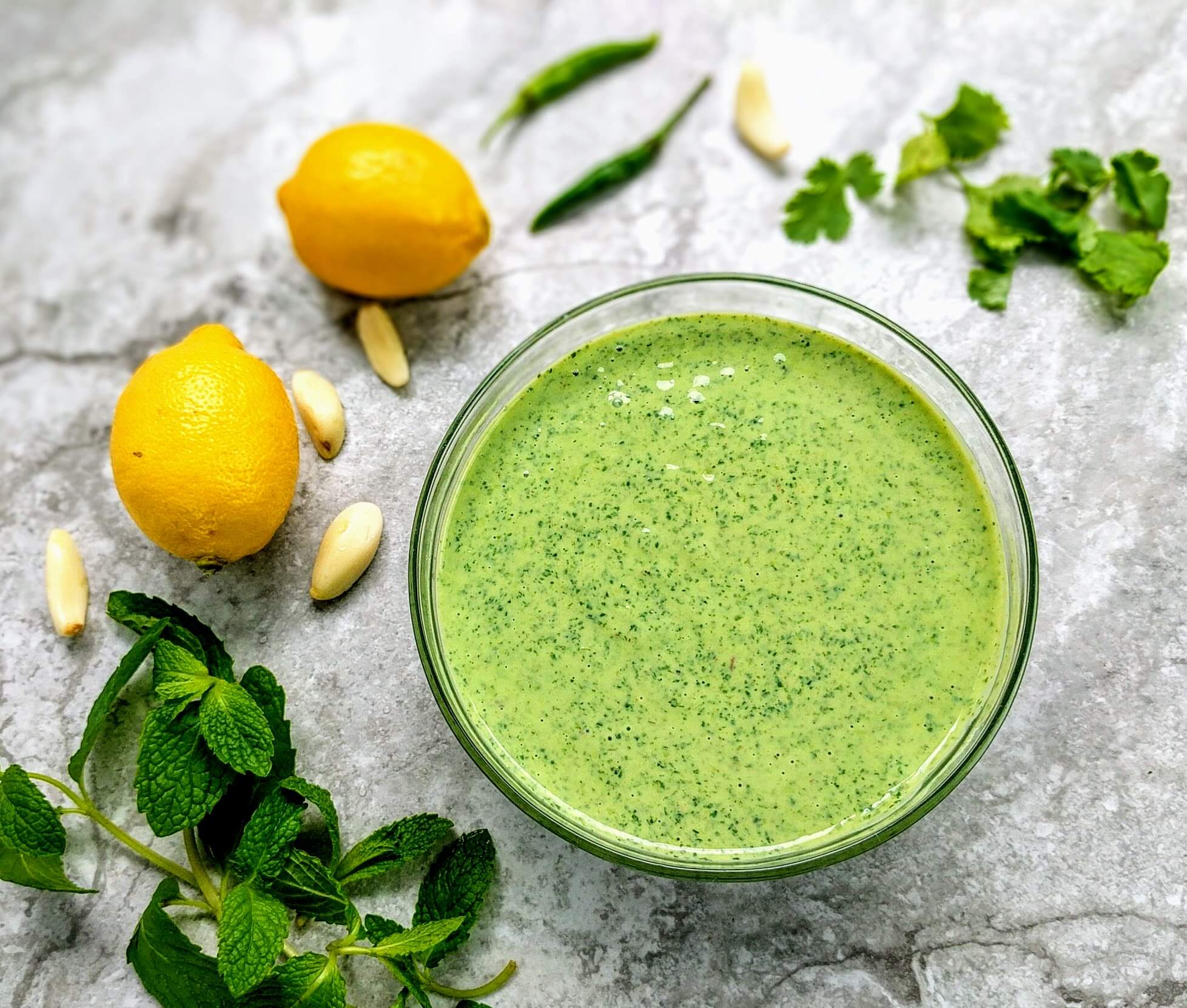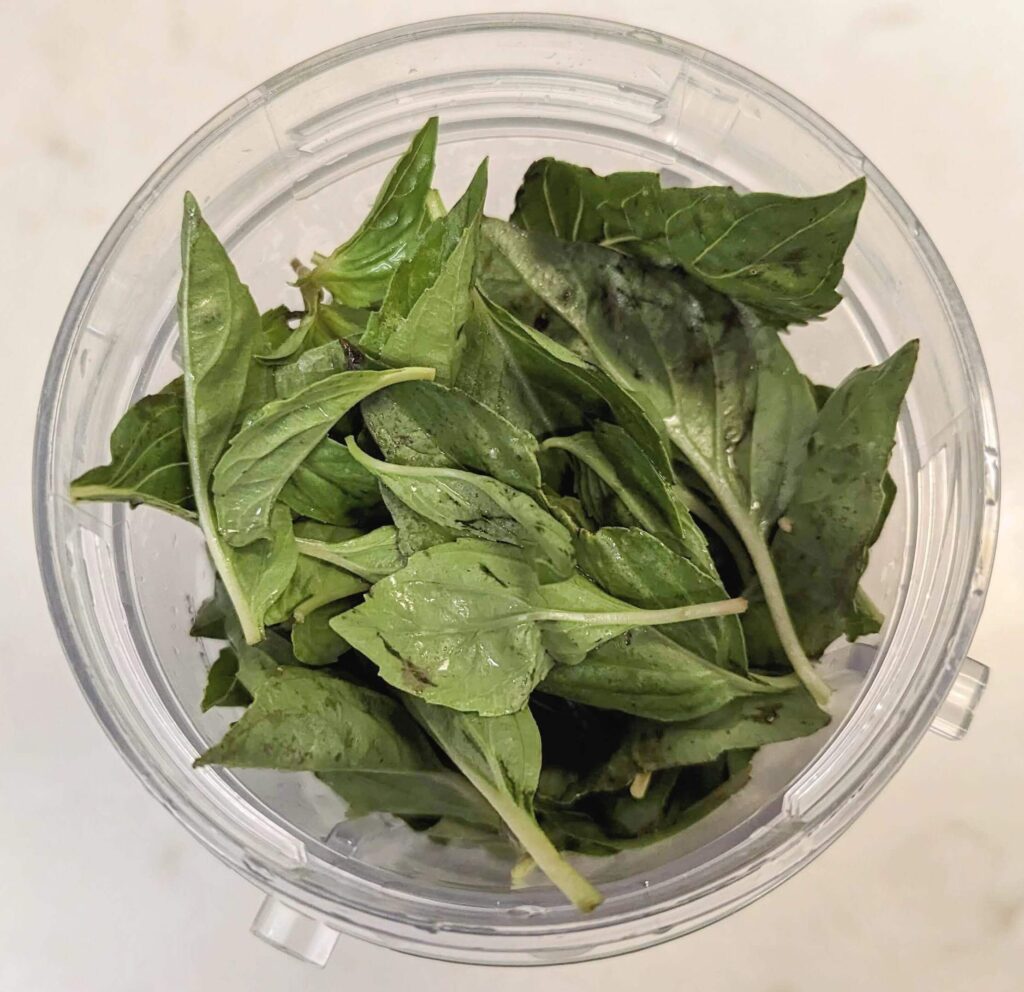About this basil pesto recipe
Basil pesto is a versatile and delicious Italian sauce made by blending fresh basil leaves with garlic, pine nuts, parmesan cheese and olive oil. This classic sauce is perfect for pasta, sandwiches or salads and can elevate any dish with its fresh, aromatic flavors.
Recipe highlights –
- Fresh, fragrant and flavorful
- Quick and easy; ready in 10 minutes
- Requires minimal ingredients.
- Customizable with ingredients you have at home
- No cooking needed
Basil pesto has a bright, fresh and herbaceous flavor that comes primarily from basil leaves. Th garlic adds pungency, pine nuts add a subtle nuttiness and the parmesan cheese offers a salty, umami richness. This combination creates a complex and delightful flavor that enhances any dish it accompanies.
History & origins of pesto
Basil pesto, also known as pesto alla Genovese, hails from the Liguria region of northwestern Italy, specifically from the city of Genoa. Its name derives from the Italian word “pestare,” meaning “to pound” or “to crush,” referring to the traditional method of preparing pesto using a mortar and pestle.
The modern version of basil pesto emerged in the 16th century when Genoese sailors brought basil back from their travels. Combining basil with local ingredients like pine nuts, parmesan cheese and garlic, pesto became a flavorful and aromatic sauce.
Pesto’s popularity grew throughout Italy and eventually spread worldwide, becoming a beloved staple in Italian cuisine. Today, it is celebrated for its vibrant green color, fresh taste, and versatility, used in a wide range of dishes from pasta to sandwiches and beyond.
Main ingredients and suggested substitutions
The following are the main ingredients used for making pesto along with some alternates and substitutions that you can make –
- Basil leaves – The star ingredient, providing the signature flavor and vibrant green color. If basil is not available, you can substitute it with other herbs like spinach, arugula or parsley for a different yet delicious twist.
- Garlic – Adds a sharp, pungent flavor. You can reduce the quantity of garlic as per your liking. If you prefer a milder taste, you can use roasted garlic instead.
- Pine nuts – Contribute a buttery texture and nutty flavor to the basil pesto. For a more budget-friendly option, you can substitute pine nuts with walnuts, almonds, or cashews.
- Parmesan cheese – Provides a rich, salty flavor and creamy texture. You can also use other Italian hard cheeses like pecorino or asiago. For a dairy-free version, you can substitute with vegan parmesan, nutritional yeast or cashews.
- Olive oil – The base that blends everything together, adding smoothness and depth. Use high-quality extra virgin olive oil for the best flavor. You can also use avocado oil or any other neutral flavored oil as an alternative.
Serving suggestions
Basil pesto is incredibly versatile and can be used in numerous ways –
- Pasta – Pesto with pasta is a classic combination and makes for a quick and flavorful meal like this sun-dried tomato and pesto pasta.
- Sandwiches and wraps – You can spread pesto on bread or wraps for an added layer of flavor.
- Salads – It goes very well as a dressing for salads, really enhancing their taste.
- Dips – It can be used as a dip for appetizers, vegetables, breadsticks, or crackers.
- Pizza – You can use it as a base sauce for pizza or drizzle on top of cooked pizza for added freshness.
- Grilled vegetables – Brush onto grilled vegetables for an extra burst of flavor.
Apart from these classical ways, you can use pesto to creatively enhance the flavor of various Indian dishes as well –
- Pesto paratha – You can spread pesto inside paratha dough before cooking.
- Pesto paneer – Marinate paneer cubes in pesto and grill or sauté for a delicious herby flavor.
- Pesto Pulao – Stir pesto into vegetable pulao for added flavor.
- Pesto dosa – Spread pesto inside dosa for a fusion flavor.
- Pesto chutney – Serve as a dip with samosas, pakoras, or fritters.
- Pesto Sandwich – Use pesto as a spread in vegetable or paneer sandwiches.
Storage instructions
You can store the pesto in an airtight container in the refrigerator for up to one week. To prevent the pesto from browning, cover the surface with a thin layer of olive oil before sealing the container.
Basil pesto also freezes well. Pour the pesto into ice cube trays and freeze. Once frozen, transfer the pesto cubes to a freezer bag or container for easy portioning. It can be stored in the freezer for up to three months. Thaw in the refrigerator or at room temperature before use.
To make fresh basil pesto at home follow the detailed step by step recipe with pictures posted below.

Fresh Basil Pesto Recipe
Recipe Info
Nutrition
Equipment
Ingredients For Fresh Basil Pesto Recipe
- 2 Cups Basil Leaves
- 1/2 Cup Pine Nuts toasted
- 1/3 Cup Parmesan Cheese grated
- 3-4 Garlic Cloves
- 1/2 Teaspoon Salt
- 1/2 Teaspoon Black Pepper
- 2 Tablespoons Lemon Juice
- 1/4 Cup Olive Oil
Step By Step Instructions for Fresh Basil Pesto Recipe
- Add pine nuts to a blender jar. You can toast the pine nuts slightly before adding. If you don't have pine nuts, you can use walnuts, almonds or cashews in the same quantity.1/2 Cup Pine Nuts

- Add fresh basil leaves to the blender. You can also add spinach, kale or arugula for a variation in flavor.2 Cups Basil Leaves

- Then add grated parmesan cheese. This is optional, you can skip adding cheese, or use another hard cheese instead.1/3 Cup Parmesan Cheese

- Then add garlic cloves, salt, pepper and lemon juice.3-4 Garlic Cloves, 1/2 Teaspoon Salt, 1/2 Teaspoon Black Pepper, 2 Tablespoons Lemon Juice

- Add in the olive oil and pulse until the ingredients are blended into a smooth paste. You can add more olive oil if the sauce is too thick.1/4 Cup Olive Oil

- Basil pesto is ready. Store it in the refrigerator in an airtight container and serve with your favorite dishes.

Before You Go...
Don't forget to Pin this post to save it for later. You can also Subscribe to our mailing list or follow us on Facebook, Pinterest, Instagram or Twitter to see more delicious food recipes.
We'd love to know your thoughts about this dish! Please leave a comment or share a picture on Facebook or Instagram with the hashtag #vegecravings.











